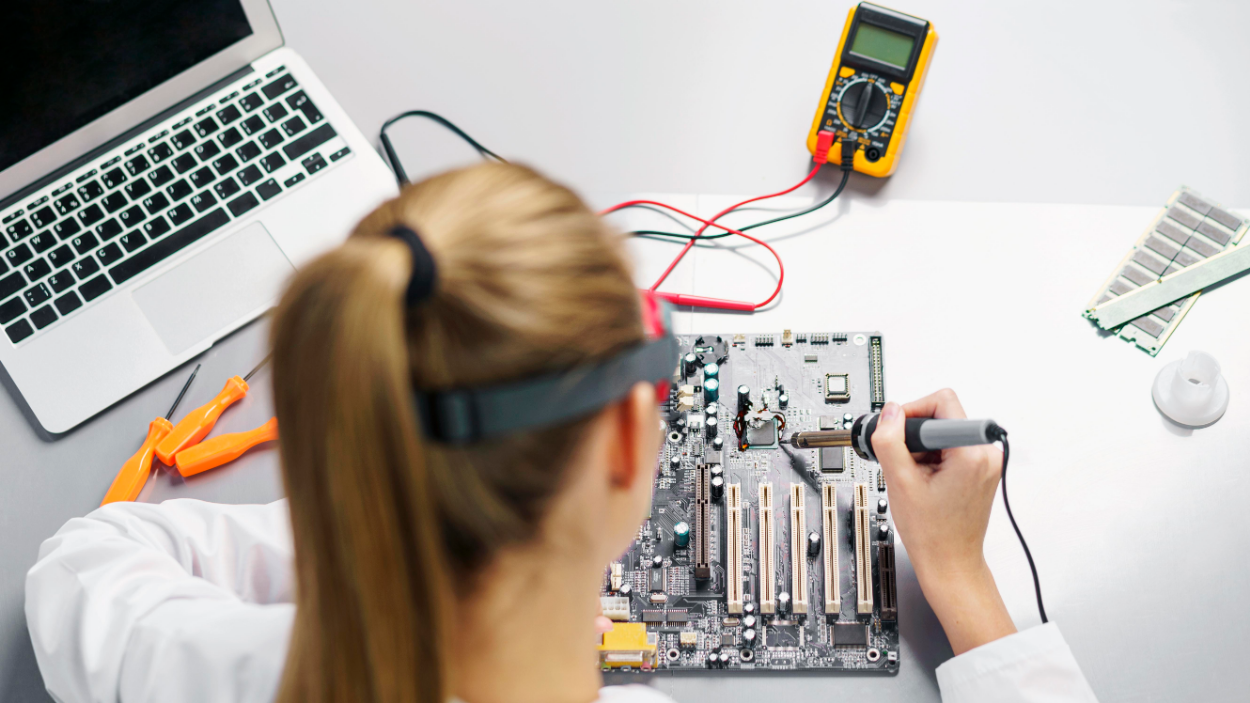Innovative Projects 2024 : 50 Ideas for Electronics Engineers
Embarking on hands-on projects is essential for electronics engineering students, as it bridges the gap between classroom learning and real-world application. This compilation of 50 top electronics engineering project ideas provides a wide array of options, from fundamental circuit constructions to cutting-edge smart technologies, ensuring that students can find projects that align with their interests and expertise. By tackling these projects, students gain valuable practical experience, develop critical thinking skills, and prepare themselves for a successful career in the dynamic field of electronics.

Smart Home Automation System Using IoT
This project involves designing a system to control home appliances remotely using Internet of Things (IoT) technology. By integrating various sensors, relays, and communication modules like Wi-Fi or Bluetooth, users can control devices such as lights, fans, and security systems via smartphones or web applications. The system may also feature automation based on environmental conditions, such as turning off lights when no motion is detected, thereby promoting energy efficiency. Cloud platforms such as Blynk or MQTT can be used for real-time monitoring and control of appliances.
Obstacle Avoiding Robot Using Arduino
This project focuses on building an autonomous robot capable of detecting and avoiding obstacles in its path using ultrasonic sensors. The robot uses an Arduino microcontroller to process sensor data and control the movement of motors. The algorithm allows the robot to take decisions in real-time, changing direction upon detecting obstacles. This type of robot finds applications in industrial automation, where autonomous machines can navigate safely within environments without human intervention.
Solar-Powered Battery Charger with MPPT
The goal of this project is to design a solar-powered battery charger with Maximum Power Point Tracking (MPPT) to optimize energy harvesting. Solar energy is variable, and MPPT helps adjust the operating point of solar panels to ensure maximum efficiency. The system comprises solar panels, a DC-DC converter, and a microcontroller-based MPPT controller, which adjusts the duty cycle of the converter to maximize the power output. This project can be applied in remote areas where grid electricity is not available, enabling the charging of batteries for various uses.
Wireless Power Transfer System
This project involves developing a system that transfers electrical energy wirelessly between two circuits through inductive coupling. The primary coil, powered by an alternating current, generates a magnetic field, which induces a current in the secondary coil located at a certain distance. Applications include wireless charging of devices such as smartphones and electric vehicles. Understanding the physics of electromagnetic fields, resonance, and power electronics is essential to the success of this project.
Voice-Controlled Wheelchair for Disabled Persons
The aim of this project is to design a wheelchair that can be controlled through voice commands, improving mobility for disabled individuals. The system uses a voice recognition module connected to a microcontroller, which interprets specific commands like “forward,” “left,” or “stop” to control the motors of the wheelchair. Additional safety features such as obstacle detection sensors or emergency stop mechanisms can be incorporated to enhance the functionality and user experience.
Smart Energy Meter with IoT
This project aims to create an IoT-based smart energy meter that measures electricity consumption in real-time and sends the data to a cloud platform for monitoring and billing purposes. Using current sensors and microcontrollers, the energy usage data is calculated and transmitted via Wi-Fi or GSM modules. Utilities can access this data to generate accurate bills, while users can track their usage through a web dashboard or mobile app, promoting energy conservation.
Automatic Street Lighting System Using LDR
The objective of this project is to design an automated street lighting system that operates based on the ambient light conditions detected by Light Dependent Resistors (LDRs). The LDR detects the intensity of sunlight and switches on the street lights at dusk and off at dawn. This system reduces energy consumption by ensuring that lights are only on when necessary. The project could also include energy-saving mechanisms such as dimming lights during low traffic hours.
IoT-Based Air Quality Monitoring System
This project involves creating an air quality monitoring system using sensors that detect pollutants like CO2, NOx, and particulate matter in the air. The sensor data is processed by a microcontroller and sent to an IoT platform via Wi-Fi or GSM for real-time monitoring. The data can be visualized on dashboards, and alerts can be triggered when pollutant levels exceed predefined thresholds. Such systems are valuable in urban environments where air pollution is a major health concern.
Gesture-Controlled Robot Using Arduino
This project focuses on designing a robot that can be controlled by human gestures using accelerometer sensors. The user wears a glove fitted with an accelerometer, and the sensor data is transmitted wirelessly to the robot’s Arduino controller. The robot then moves in accordance with the direction of the gestures. Gesture-controlled robots have potential applications in healthcare for assisting individuals with limited mobility, as well as in entertainment and interactive installations.
Smart Water Level Monitoring and Controlling System
The goal of this project is to develop a system that monitors the water level in a tank and automatically controls the water pump. Ultrasonic or float sensors are used to measure the water level, and based on predefined thresholds, the pump is activated or deactivated to maintain the water level within a desired range. The system can be extended by incorporating IoT to remotely monitor water levels via a smartphone or web app, offering practical applications in water management systems.
RFID-Based Attendance System
This project involves creating an RFID-based attendance system where students or employees can mark their attendance by swiping an RFID card. The system consists of an RFID reader connected to a microcontroller, which records the unique ID of each card and stores the data in a database. This automated system reduces manual errors in attendance tracking and can be used in schools, offices, or factories. It can also generate reports for better attendance management.
Automated Plant Irrigation System Using Sensors
This project aims to develop a smart irrigation system that waters plants automatically based on soil moisture levels. A soil moisture sensor detects the water content in the soil, and when the moisture level falls below a set threshold, a pump is activated to water the plants. This system conserves water by ensuring that irrigation only occurs when necessary, making it ideal for agriculture or garden management. IoT integration can be added for remote monitoring and control.
Biometric Authentication System Using Fingerprint Scanner
This project involves designing a biometric authentication system using a fingerprint scanner. The system captures a fingerprint image and compares it against a stored database for identity verification. It is used in access control systems for high-security areas or personal devices. The project covers the implementation of fingerprint scanning algorithms, database management, and microcontroller programming.
Remote-Controlled Car with Bluetooth
This project involves designing a remote-controlled car that can be operated via a smartphone using Bluetooth. The car’s movement is controlled by sending commands from a Bluetooth-enabled device to the car’s microcontroller, which interprets the commands and drives the motors accordingly. This project demonstrates the integration of wireless communication with microcontrollers and provides practical experience in designing remote-controlled systems.
Home Security System with Motion Detection and Alarm
This project focuses on creating a home security system that detects motion using passive infrared (PIR) sensors. When motion is detected within a secured area, the system triggers an alarm or sends a notification to the homeowner. The project can be enhanced by adding a camera for capturing images of intruders or connecting the system to a cloud platform for remote monitoring.
Digital Dice Using 555 Timer IC
The objective of this project is to build an electronic dice using a 555 timer IC. The timer generates a random number between 1 and 6, which is displayed on a 7-segment display. The project provides insights into the working of the 555 timer in astable mode and digital display technologies, offering a fun and interactive way to understand basic electronic components and circuits.
Smart Door Lock System with Face Recognition
This project aims to develop a smart door lock system that uses facial recognition for access control. A camera captures the face of a person standing in front of the door, and image processing algorithms are used to compare the face with a stored database of authorized users. If the match is successful, the door unlocks. This system is designed for enhanced security and convenience in residential or commercial buildings.
Temperature and Humidity Monitoring System Using DHT11
This project involves creating a simple system to monitor temperature and humidity using the DHT11 sensor. The sensor data is processed by a microcontroller, which displays the readings on an LCD screen or transmits the data wirelessly to a smartphone or cloud platform for remote monitoring. This project is ideal for weather stations, greenhouses, or climate-controlled environments.
Solar-Powered Smart Irrigation System
The goal of this project is to design a smart irrigation system powered by solar energy. The system uses soil moisture sensors to monitor the water content in the soil and controls a water pump accordingly. Solar panels provide the energy required to power the system, making it sustainable and ideal for use in remote areas where electricity is scarce. IoT can be integrated for remote control and monitoring of the system.
Heart Rate Monitoring System Using Pulse Sensor
This project involves developing a heart rate monitoring system using a pulse sensor, which detects the pulse rate through a finger or earlobe. The sensor data is processed by a microcontroller, which calculates the beats per minute (BPM) and displays the result on an LCD screen. The system can be further enhanced by adding Bluetooth or Wi-Fi connectivity to send the data to a smartphone for health tracking.
Smart Traffic Light System Using IoT
This project aims to develop a smart traffic light system that optimizes traffic flow using real-time data. Sensors are placed at intersections to measure traffic density, and based on the collected data, the traffic light timing is adjusted dynamically. The system can also be connected to an IoT platform to provide real-time updates to authorities or motorists. By reducing congestion and improving traffic management, this system could be implemented in urban areas to enhance traffic efficiency and safety.
Power Line Fault Detection System Using GSM
This project involves designing a system that detects faults in power lines and sends an alert to the maintenance team via GSM. Sensors are deployed along power lines to monitor parameters such as current and voltage. When an abnormal condition, such as a short circuit or line break, is detected, the system sends a message with the fault location to a predefined phone number. This project helps reduce downtime by enabling quick responses to faults in power distribution systems.
Anti-Theft Alarm System for Vehicles
The objective of this project is to create an anti-theft alarm system for vehicles. The system uses motion or vibration sensors to detect unauthorized attempts to move or tamper with the vehicle. If such activity is detected, the system triggers an alarm and can also send an SMS alert to the vehicle owner via a GSM module. This project provides a practical solution for vehicle security, reducing the chances of theft or damage.
GSM-Based Home Automation System
This project involves creating a home automation system that allows users to control home appliances via SMS using a GSM module. The system is based on a microcontroller, which receives text commands sent by the user and triggers relays to turn appliances on or off. This approach offers a simple and cost-effective solution for remotely controlling home devices, especially in areas without internet connectivity.
Wearable Health Monitoring System
This project aims to develop a wearable device that continuously monitors vital health parameters such as heart rate, body temperature, and oxygen levels. The data is collected by sensors integrated into the wearable and transmitted wirelessly to a smartphone or cloud platform for real-time monitoring. This system can be useful for tracking patient health, especially for elderly individuals or those with chronic conditions, and can alert caregivers in case of abnormal readings.
Smart Grid System for Energy Optimization
The goal of this project is to design a smart grid system that optimizes energy distribution and consumption using real-time data. The system integrates sensors and smart meters across the grid to monitor energy flow and detect inefficiencies. Algorithms are then used to dynamically allocate energy resources, reduce losses, and balance the load across the grid. This project plays a crucial role in modernizing power systems, making them more efficient and resilient.
Arduino-Based Smart Parking System
This project involves developing an automated parking system using Arduino and sensors to detect the availability of parking spaces. Ultrasonic sensors are installed in each parking slot, and the data is sent to a central control unit, which displays the available spaces on an LED screen or mobile app. The system can also guide vehicles to available spaces in large parking lots, reducing the time spent searching for parking.
Load Sharing of Transformers Using Microcontroller
This project focuses on creating a system to balance the load among multiple transformers in a power distribution network. A microcontroller is used to monitor the load on each transformer and redistribute the load if one transformer becomes overloaded. This prevents damage to transformers due to overloading and ensures efficient use of power distribution equipment. This project is essential in power management for ensuring reliability in the grid.
Prepaid Electricity Billing System
The objective of this project is to design a prepaid electricity billing system where users pay for electricity in advance. The system consists of an energy meter connected to a microcontroller that tracks energy consumption and deducts the corresponding amount from the prepaid balance. When the balance is low, the system can alert the user or disconnect the supply until more credit is purchased. This project encourages responsible energy usage and simplifies billing for utility companies.
Line Follower Robot Using IR Sensors
This project involves building a robot that can follow a predefined path using infrared (IR) sensors. The robot is equipped with IR sensors that detect the contrast between the path (usually a black line) and the surrounding surface (typically white). The microcontroller processes the sensor data and adjusts the motor speed and direction to keep the robot on the path. Line follower robots are widely used in industrial automation and logistics for tasks such as material handling and transportation.
Voice-Controlled Home Automation Using Google Assistant
This project focuses on designing a home automation system controlled through voice commands using Google Assistant. The system integrates smart devices like lights, fans, and appliances with an IoT platform such as Google Home. Voice commands are processed by the Google Assistant, which communicates with a microcontroller to control the connected devices. This project offers a hands-free and user-friendly solution for automating household tasks.
Automatic Railway Crossing Gate Control
This project aims to design an automatic system that controls railway crossing gates. Sensors placed along the tracks detect the approaching train, and the system automatically lowers the gate to prevent vehicles from crossing. Once the train has passed, the gate is raised. This project enhances safety at railway crossings, especially in remote areas where manual gate operation is not feasible.
IoT-Based Smart Agriculture System
The goal of this project is to develop a smart agriculture system that monitors and controls various parameters such as soil moisture, temperature, and humidity using IoT technology. The system uses sensors to collect data from the field, which is then processed by a microcontroller and sent to a cloud platform. Farmers can monitor the conditions and control irrigation or other systems remotely through a smartphone app, helping to optimize crop yields and reduce water usage.
Smart Helmet for Accident Detection
This project involves designing a smart helmet equipped with sensors to detect accidents and send alerts. The system includes an accelerometer and gyroscope to detect abnormal motion or impact. In case of an accident, the system sends the location of the incident via GPS and an alert message through GSM to emergency contacts. This project is useful for enhancing road safety, especially for motorcyclists.
GPS Tracker for Lost Devices Using GSM
The objective of this project is to build a GPS tracking system that helps locate lost or stolen devices. A GPS module provides the real-time location of the device, and the GSM module sends the coordinates to a predefined phone number via SMS. The project can be applied to track vehicles, luggage, or personal items. It provides a cost-effective solution for asset tracking and theft prevention.
Electronic Voting Machine (EVM) Using Arduino
This project focuses on designing an electronic voting machine using Arduino. Voters press buttons corresponding to their candidate choices, and the system registers the vote. Once the voting process is completed, the microcontroller tallies the votes and displays the results. The system ensures that voting is secure, accurate, and tamper-resistant, making it a suitable replacement for manual voting systems.
Power Factor Correction Using Microcontroller
The goal of this project is to design a system that automatically corrects the power factor of electrical loads. The system monitors the power factor and activates capacitors or inductors to bring the power factor closer to unity. This helps improve the efficiency of power distribution and reduces the reactive power in the system. Power factor correction is essential in industrial settings to avoid penalties from utility companies and to improve equipment performance.
DC Motor Speed Control Using PWM Technique
This project involves developing a system to control the speed of a DC motor using Pulse Width Modulation (PWM). The microcontroller generates a PWM signal, which adjusts the average voltage applied to the motor, thereby controlling its speed. This technique is widely used in applications such as robotics, industrial automation, and electric vehicles, where precise control of motor speed is required.
Smart Fire Alarm System Using Flame Sensor
This project focuses on creating a fire alarm system that detects fire using a flame sensor. When a flame is detected, the system triggers an alarm and can also send a notification to the fire department or building owner via GSM or Wi-Fi. The project can be enhanced by adding temperature sensors or smoke detectors for early fire detection, making it suitable for use in homes, offices, or industrial settings.
IoT-Based Water Quality Monitoring System
The objective of this project is to develop a water quality monitoring system using IoT technology. The system uses sensors to measure parameters such as pH, turbidity, dissolved oxygen, and temperature. The collected data is sent to a cloud platform for real-time monitoring. This system is useful in applications such as water treatment plants, aquaculture, or environmental monitoring, where maintaining water quality is critical.
Bluetooth-Controlled Home Appliances
This project involves designing a system to control home appliances via Bluetooth. A smartphone app sends control signals to a Bluetooth module connected to a microcontroller, which activates or deactivates relays controlling the appliances. This system offers a simple and cost-effective solution for home automation, allowing users to control devices within a limited range using their phones.
Electric Vehicle Charging Station Design
This project focuses on designing an electric vehicle (EV) charging station that can efficiently charge EVs using renewable energy sources such as solar power. The station includes power electronics to convert and manage the energy supplied to the vehicle’s battery. Additionally, the system can feature IoT integration for monitoring and managing multiple charging points, optimizing energy use, and providing real-time data to users via mobile apps.
Microcontroller-Based Temperature Control System
This project involves designing a temperature control system that uses sensors to measure the temperature of an environment and controls heating or cooling devices to maintain a desired temperature range. The system can be used in applications such as HVAC systems, greenhouses, or industrial processes where maintaining a specific temperature is critical. The microcontroller processes the temperature data from sensors like thermistors or DHT11, and based on the set threshold, activates the heating or cooling elements via relays. The system can also feature a display or communication module for real-time temperature monitoring.
Smart Waste Management System Using IoT
The goal of this project is to design a smart waste management system that uses sensors to monitor the fill level of garbage bins and sends real-time data to waste collection authorities. Ultrasonic sensors measure the level of waste in the bin, and when it reaches a certain threshold, a notification is sent via Wi-Fi or GSM to alert the relevant authorities. This system ensures that bins are emptied before they overflow, improving the efficiency of waste collection and promoting cleanliness in urban areas.
Electricity Theft Detection System
This project involves designing a system to detect electricity theft in power distribution networks. Sensors are installed at various points along the distribution lines to measure parameters such as current and voltage. By comparing the data from these sensors with the total energy consumption reported by smart meters, the system can identify discrepancies that may indicate theft. The system can send alerts to utility companies for further investigation, helping to reduce losses and improve the integrity of the power grid.
Smart Solar Tracking System
The objective of this project is to design a solar tracking system that increases the efficiency of solar panels by automatically adjusting their orientation to follow the movement of the sun. The system uses light-dependent resistors (LDRs) to detect the sun’s position and a microcontroller to control motors that adjust the tilt of the solar panel. By keeping the panel aligned with the sun throughout the day, this project maximizes energy capture, making solar power generation more efficient.
RFID-Based Smart Shopping Cart
This project focuses on creating a smart shopping cart that uses RFID technology to automate the billing process in supermarkets. Each item in the store is tagged with an RFID label, and when the customer places an item in the cart, an RFID reader installed in the cart automatically registers the item and adds it to the bill. At checkout, the customer can simply pay the total amount without needing to scan each item individually. This project improves the shopping experience and reduces the time spent at checkout.
Home Automation System Using Zigbee Technology
This project involves developing a home automation system that uses Zigbee communication for wireless control of home appliances. Zigbee is a low-power, low-cost wireless communication technology ideal for smart home applications. The system consists of sensors, actuators, and a central control unit that communicates with the devices via Zigbee. Users can control appliances such as lights, fans, and security systems through a central hub or smartphone app, providing a scalable and energy-efficient home automation solution.
IoT-Based Weather Station
This project aims to create a weather station that monitors environmental parameters such as temperature, humidity, atmospheric pressure, and wind speed using various sensors. The sensor data is processed by a microcontroller and sent to an IoT platform, where it is displayed in real-time and stored for analysis. This project can be used in agricultural fields, schools, or environmental monitoring systems to provide accurate and timely weather information.
Automated Toll Collection System Using RFID
The goal of this project is to design an automated toll collection system using RFID technology. Vehicles passing through the toll gate are equipped with RFID tags, which are scanned by an RFID reader installed at the gate. The toll fee is automatically deducted from the vehicle owner’s prepaid account, and the gate opens without requiring the vehicle to stop. This project improves traffic flow at toll plazas, reduces congestion, and eliminates the need for manual toll collection.
PCBWay in Electronics Engineering Projects
PCBWay stands out as a trusted partner for electronics students by providing essential PCB fabrication and prototyping services, tailored to meet the demands of academic projects. Practical electronics projects are crucial for students, as they bridge the gap between theoretical learning and real-world application, allowing them to develop essential design, troubleshooting, and implementation skills. PCBWay supports these endeavors with its high-precision manufacturing processes, quick delivery options, and a wide range of services, from basic PCBs to advanced multilayer designs, ensuring students can realize even the most complex ideas efficiently.

In addition to quality fabrication, PCBWay also offers valuable resources to students, including a sponsorship program aimed at supporting innovative academic projects. This initiative not only reduces the financial burden on students but also fosters creativity and technical growth by providing access to professional-grade PCBs. With easy-to-use online tools for ordering and tracking, PCBWay makes the entire process—from design submission to receiving the final product—seamless for students. This level of support plays a significant role in helping aspiring engineers successfully complete their projects, advancing their knowledge and preparing them for future challenges in the electronics industry.
Conclusion
In summary, these 50 project ideas serve as an essential resource for electronics engineering students seeking to deepen their understanding and skills. Each project offers a unique opportunity to explore various technologies, from microcontroller programming and IoT integration to renewable energy and automation. By working on these projects, students not only apply theoretical knowledge but also gain hands-on experience, enhancing their problem-solving and design capabilities. These projects are invaluable for building a strong foundation in electronics, preparing students for the dynamic demands of the industry, and fostering innovation that can lead to real-world technological advancements.






